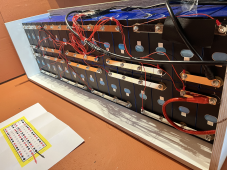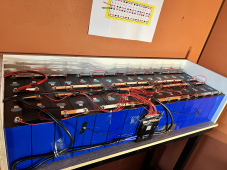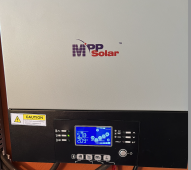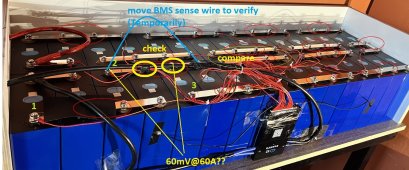Hello guys. My setup has been under observation for the last 10 days and would like to ask your inputs on the best practice on how to deal with the faster (and slower) cells on what I could only conclude as those with lower or higher internal resistance than the rest.
1. The 32 cells are Eve 280k, all came from Shenzhen Basen with about similar mfg dates. Since I am using a JK BMS with around 2A active balancer, I did not bother to top balance the cells so after completing the wiring, they are immediately charged by solar (no AC) using the MPP 5048 MGX in an off-grid setup. They are snug fitted on a 3/4 plywood (not compressed) and will be closed soon. This is a 48v setup, bulk charge at 57.6v, float at 54v, cutoff at 48v. Cells start to balance at 3.4v and 0.01v delta. For the past 10 days, I did not see the voltage at the batteries past the 54.4v mark, current always tapers until it reaches around less than 1A, even if the sun is still out.

2. I noticed that there are certain group of cells that stand out from the rest. Upon charging, cell group 1 seem to be a slow starter, always a laggard in reaching the voltage vis-a-vis the rest. Cell group 3 charges really fast. While group 1 is at 3.36v, group 3 is now at 3.43v.
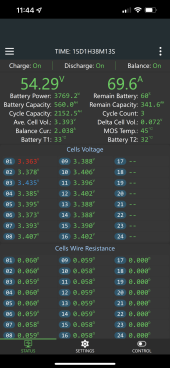
3. At the higher state of charge, delta is less than 0.01v, indicating that the balancing worked well.

4. However, when they are discharging, cell group 3 seems to have no pacing at all, discharging voltage like there's no tomorrow. Here, they are now at 3.10v, switching places with group 1 who are still at 3.17v while the rest are around 3.14-3.15v.
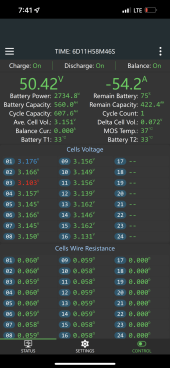
5. At the discharged state, cell group 3 is now almost empty at 2.95v. The rest are still above 3.17-3.19v.
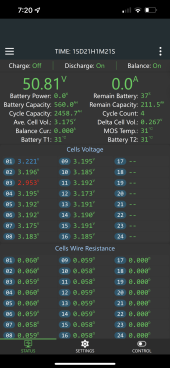
So, any suggestions or opinions on how to deal with this? My goal is just a 90%-15% SOC usage but it will be preferable to maximize the energy as much as possible since we are not only looking for a battery but a hobby as well. Some options:
Some options:
1. Try to switch partners with 1 and 3 to 'balance' out the internal resistances.
2. Charge to full and top balance cell group 1 only.
3. Clean the terminals.
4. Dont worry about it as they are normal.
1. The 32 cells are Eve 280k, all came from Shenzhen Basen with about similar mfg dates. Since I am using a JK BMS with around 2A active balancer, I did not bother to top balance the cells so after completing the wiring, they are immediately charged by solar (no AC) using the MPP 5048 MGX in an off-grid setup. They are snug fitted on a 3/4 plywood (not compressed) and will be closed soon. This is a 48v setup, bulk charge at 57.6v, float at 54v, cutoff at 48v. Cells start to balance at 3.4v and 0.01v delta. For the past 10 days, I did not see the voltage at the batteries past the 54.4v mark, current always tapers until it reaches around less than 1A, even if the sun is still out.

2. I noticed that there are certain group of cells that stand out from the rest. Upon charging, cell group 1 seem to be a slow starter, always a laggard in reaching the voltage vis-a-vis the rest. Cell group 3 charges really fast. While group 1 is at 3.36v, group 3 is now at 3.43v.

3. At the higher state of charge, delta is less than 0.01v, indicating that the balancing worked well.

4. However, when they are discharging, cell group 3 seems to have no pacing at all, discharging voltage like there's no tomorrow. Here, they are now at 3.10v, switching places with group 1 who are still at 3.17v while the rest are around 3.14-3.15v.

5. At the discharged state, cell group 3 is now almost empty at 2.95v. The rest are still above 3.17-3.19v.

So, any suggestions or opinions on how to deal with this? My goal is just a 90%-15% SOC usage but it will be preferable to maximize the energy as much as possible since we are not only looking for a battery but a hobby as well.
1. Try to switch partners with 1 and 3 to 'balance' out the internal resistances.
2. Charge to full and top balance cell group 1 only.
3. Clean the terminals.
4. Dont worry about it as they are normal.



